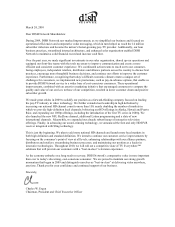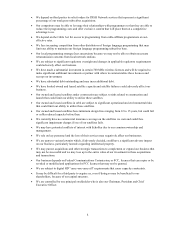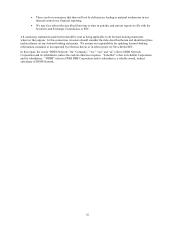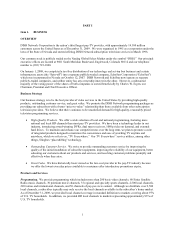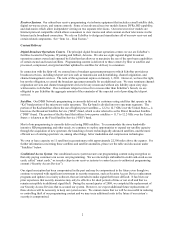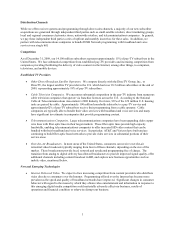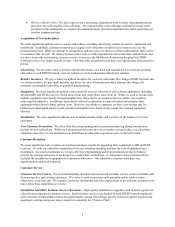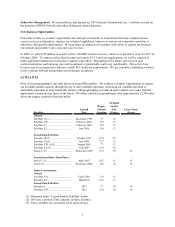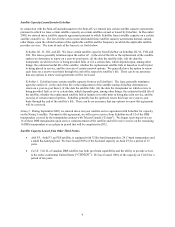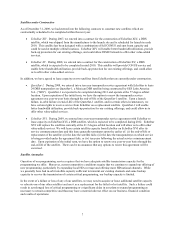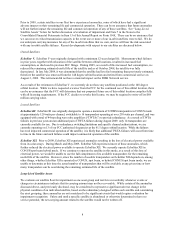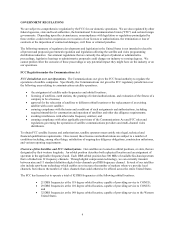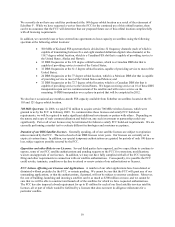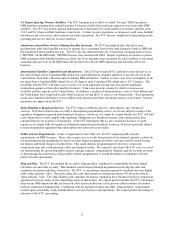Dish Network 2009 Annual Report Download - page 12
Download and view the complete annual report
Please find page 12 of the 2009 Dish Network annual report below. You can navigate through the pages in the report by either clicking on the pages listed below, or by using the keyword search tool below to find specific information within the annual report. 2
Receiver Systems. Our subscribers receive programming via in-home equipment that includes a small satellite dish,
digital set-top receivers, and remote controls. Some of our advanced receiver models feature DVRs, HD capability,
and dual-tuners which allow independent viewing on two separate televisions. Our newest receiver models are
Internet-protocol compatible which allows consumers to view movies and other content on their televisions via the
Internet and a broadband connection. We rely on EchoStar to design and manufacture all of our new receivers and
certain related components. See “Item 1A – Risk Factors.”
Content Delivery
Digital Broadcast Operations Centers. The principal digital broadcast operations centers we use are EchoStar’s
facilities located in Cheyenne, Wyoming and Gilbert, Arizona. We also use eight regional digital broadcast
operations centers owned and operated by EchoStar that allow us to maximize the use of the spot beam capabilities
of certain owned and leased satellites. Programming content is delivered to these centers by fiber or satellite and
processed, compressed, encrypted and then uplinked to satellites for delivery to consumers.
In connection with the Spin-off, we entered into a broadcast agreement pursuant to which EchoStar provides us
broadcast services, including teleport services such as transmission and downlinking, channel origination, and
channel management services. The term of this agreement expires on January 1, 2011. However, we have the right,
but not the obligation, to extend the broadcast agreement annually for an additional year. We may terminate channel
origination services and channel management services for any reason and without any liability upon sixty days
written notice to EchoStar. If we terminate teleport services for a reason other than EchoStar’s breach, we are
obligated to pay EchoStar the aggregate amount of the remainder of the expected cost of providing the teleport
services.
Satellites. Our DISH Network programming is currently delivered to customers using satellites that operate in the
“Ku” band portion of the microwave radio spectrum. The Ku-band is divided into two spectrum segments. The
portion of the Ku-band that allows the use of higher power satellites 12.2 to 12.7 GHz over the United States is
known as the Broadcast Satellite Service (“BSS”) band, which is also referred to as the Direct Broadcast Satellite
(“DBS”) band. The portion of the Ku-band that utilizes lower power satellites 11.7 to 12.2 GHz over the United
States is known as the Fixed Satellite Service (“FSS”) band.
Most of our programming is currently delivered using DBS satellites. To accommodate the more bandwidth-
intensive HD programming and other needs, we continue to explore opportunities to expand our satellite capacity
through the acquisition of new spectrum, the launching of more technologically advanced satellites, and the more
efficient use of existing spectrum via, among other things, better modulation and compression technologies.
We own or lease capacity on 11 satellites in geostationary orbit approximately 22,300 miles above the equator. For
further information concerning these satellites and satellite anomalies, please see the table and discussion under
“Satellites” below.
Conditional Access System. Our conditional access system secures our programming content using encryption so
that only paying customers can access our programming. We use microchips embedded in credit card-sized access
cards, called “smart cards,” or security chips in our receiver systems to control access to authorized programming
content (“Security Access Devices”).
Our signal encryption has been compromised in the past and may be compromised in the future even though we
continue to respond with significant investment in security measures, such as Security Access Device replacement
programs and updates in security software, that are intended to make signal theft more difficult. It has been our
prior experience that security measures may only be effective for short periods of time or not at all and that we
remain susceptible to additional signal theft. During the second quarter of 2009, we completed the replacement of
our Security Access Devices that re-secured our system. However, we expect additional future replacements of
these devices will be necessary to keep our system secure. We cannot ensure that we will be successful in reducing
or controlling theft of our programming content and we may incur additional costs in the future if our system’s
security is compromised.



